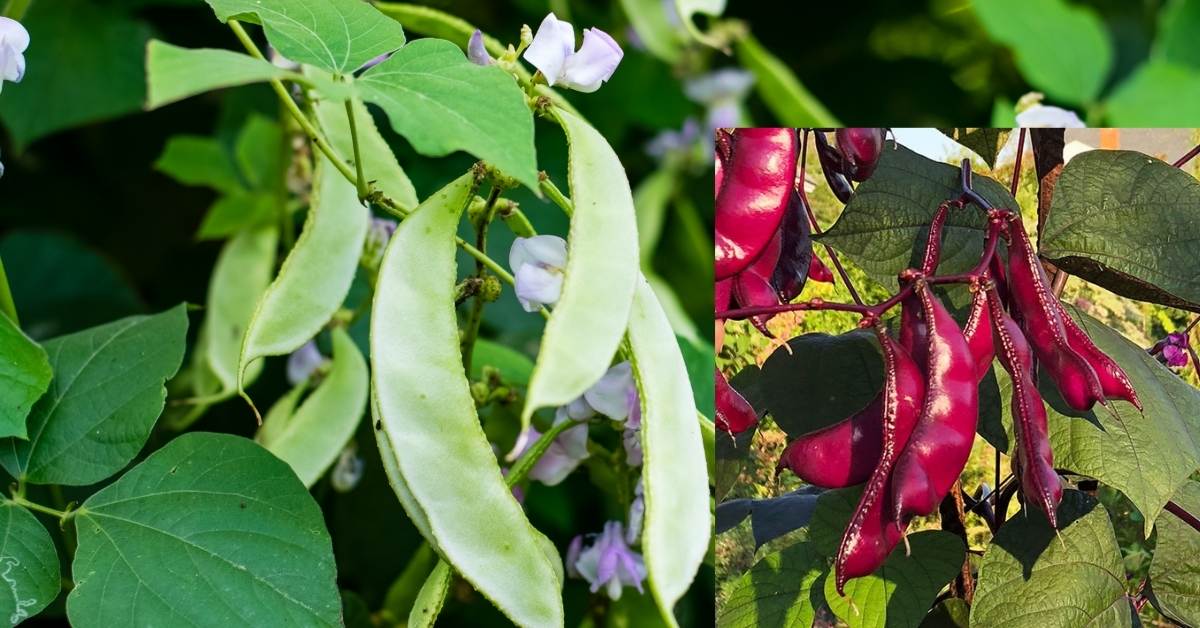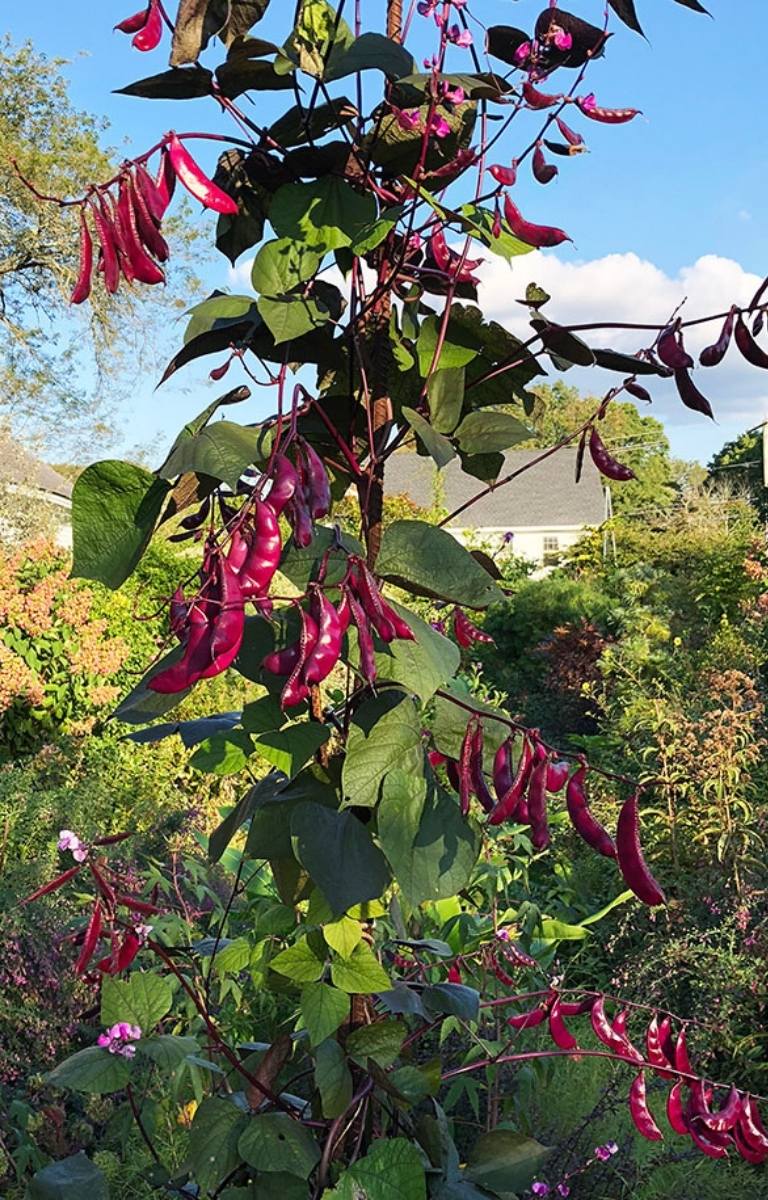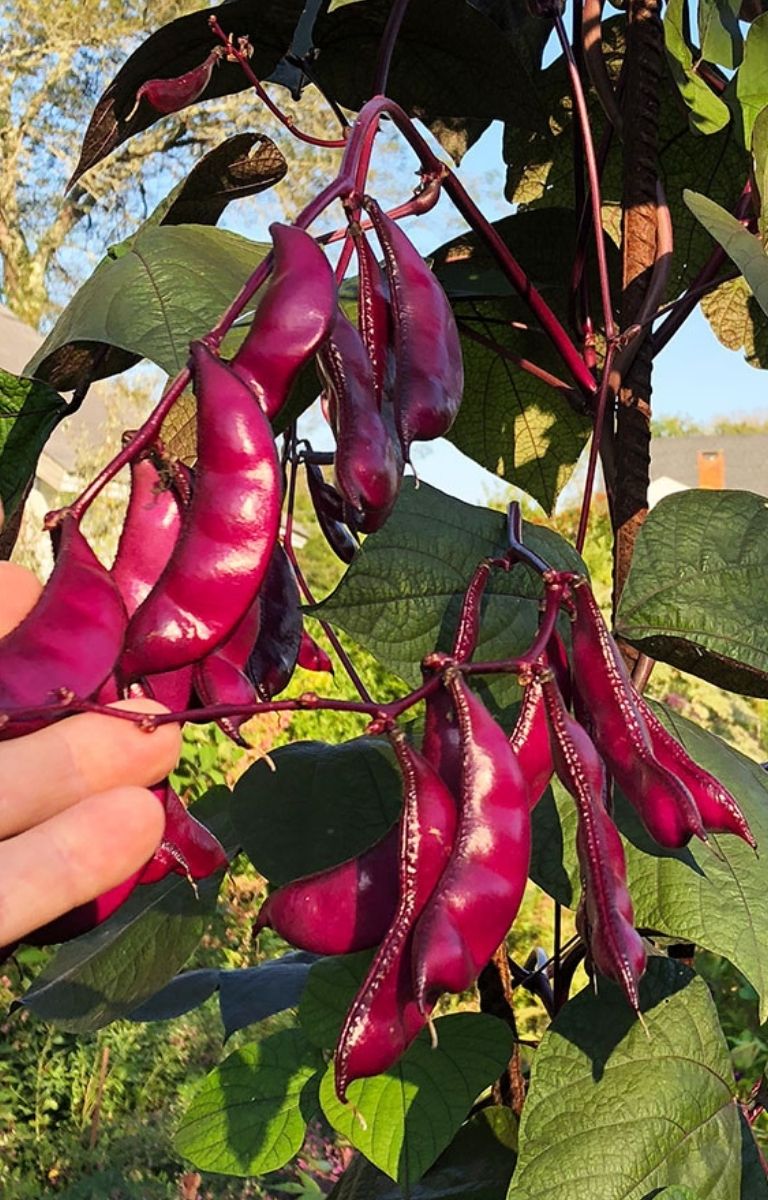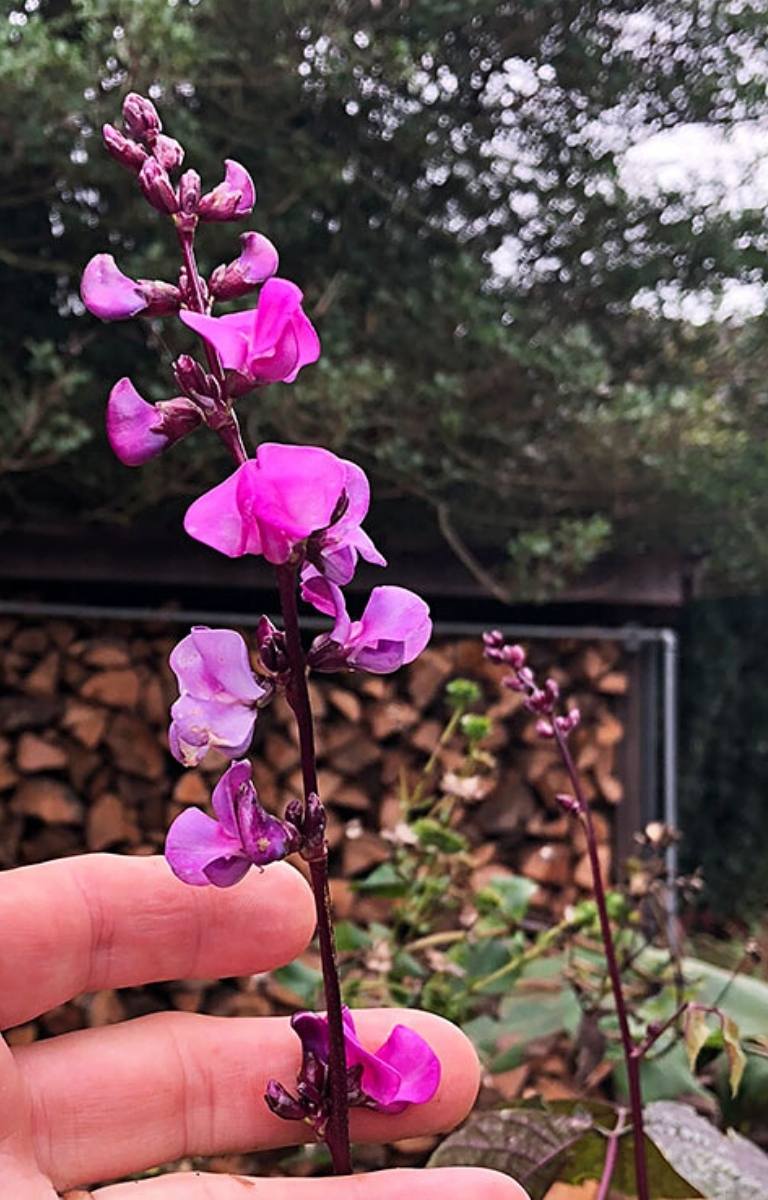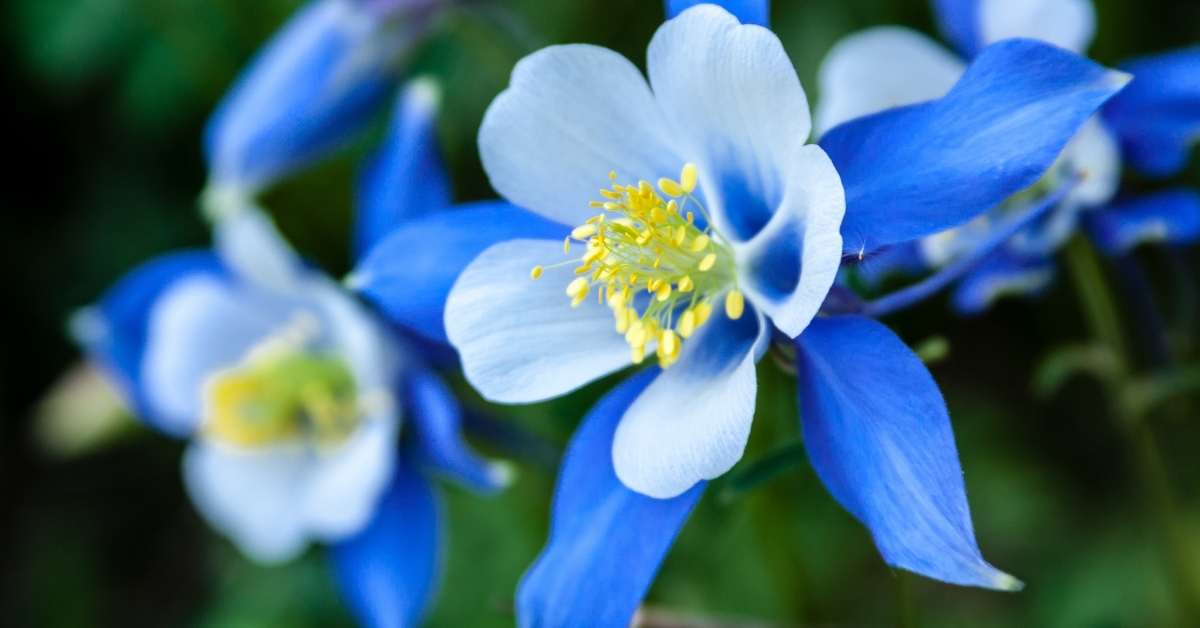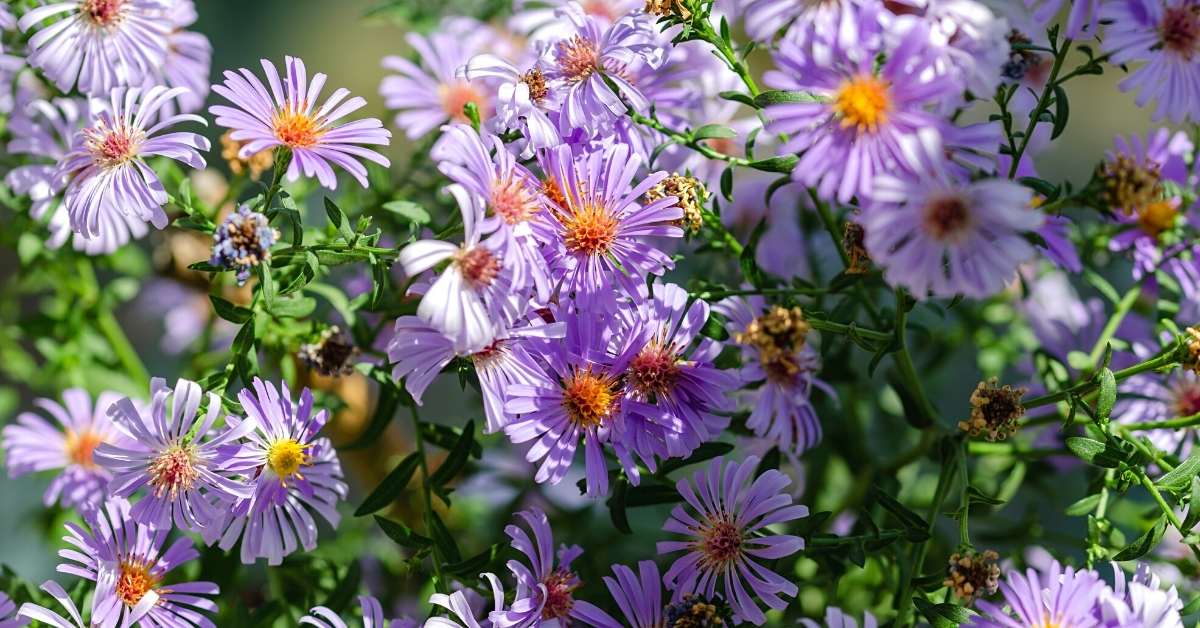It’s the rare vegetable that’s showy enough for the garden at large. What others are there besides fancy-leaved kale, cardoons, Jerusalem artichokes, and artisanal grains such as broom corn and amaranth?
Dolichos Lablab! This astonishing bean is grown worldwide as animal fodder and for human consumption of its flowers, foliage, roots, and pods. It’s also grown worldwide as a garden ornamental.
Here, the glossy rhubarb-pink pods glint in the sun.
They would seem to be oiled or shined-up, but no: Their reflective surface is due to a smooth surface-enhanced, likely, by a thin waxy coating.
The long spikes of pink flowers earlier in the season are singular, as well.
Then, there’s the foliage. It’s large and very dark green, with purple veins and backsides.
Even if Lablab purpureus never flowered or “podded” or had interesting foliage, it would still be worth growing just so that you could pronounce the humorous common name, “lab-lab.”
Latin Name:
Lablab purpureus, formerly Dolichos lablab
Synonyms
Lablab purpureus L. Sweet; Dolichos lablab L; Dolichos purpureus L; Dolichos lablab ssp ensiformis Thunb; Dolichos cultratus Thunb; Dolichos bengalensis Jacq; Dolichos lablab var; hortensis Schweinf & Muschler; Dolichos albus Lour; Dolichos uniflorus; Dolichos lablab ssp bengalensis Jacq; Lablab niger Medik; Lablab vulgaris Savi; Lablab leucocarpos Davi; Lablab purpureus ssp purpureus Verdc; Lablab vulgaris var; niger DC; Lablab purpureus ssp uncinatus Verdc; Lablab perennans DC; Lablab nankinicus Savi; Lablab purpureus ssp bengalensis (Jacq.) Verdc.
Common Names
- Dolichos bean,
- Hyacinth bean,
- Bonavist bean,
- Seim bean,
- Lablab bean,
- Egyptian kidney bean,
- Indian bean,
- Common bean,
- Field bean,
- Pendal bean,
- Pole bean,
- Waby bean (English);
- Avare,
- Chapparadavare,
- Chikkadikai (Kannada, India);
- Avari,
- Mochai (Tamil, India);
- Anumulu,
- Chikkudu (Telugu, India);
- Avara,
- Mochakotta (Malayalam, India);
- Sem, Ballar (Hindi, India);
- Shim (Bengali, India);
- Val (Gujarathi, India);
- Pavta, Wal (Marathi, India);
- Sin bean (Assam, India);
- Agni guango ahura (Ivory coast);
- Australian pea,
- Bannabees (Guyana);
- Batao, Batau, Beglau,
- Parda,
- Agaya,
- Itab (Philippines);
- Bounavista pea,
- Seim bean,
- Sem (Trinidad);
- Bunabis (Grenada.);
- Butter bean (Bah., Dom., Guy.);
- Caraota Chivata (Venzula);
- Chiancha Japanese (Spain);
- Chimbolo Verde (Costa Rica);
- Dauvan, Dall van (Vietnam);
- Dolic (d’ Egypte),
- Ataque, D. du Soudan, Feved Egypte (France);
- F, Cabellero (Salvador);
- Frijol bocon, F chileno (Peru);
- F.de la tierra (Cuba);
- Fuji-mame (Japan);
- Gallinazo blanco (Venezuela);
- Gallinita (Mexico);
- O- cala,
- Amora guaya,
- Gerenga (Ethiopia);
- Gueshrangaig (Egypt);
- Haricot cutelinho (Portugal);
- Helmbohne (Germany);
- Kashrengeig (Sudan);
- Kachang Kara,
- Kara-Kara,
- Kekara (Malaysia);
- Kerara (Indonesia);
- Fiwi bean,
- Kikuyu bean (East Africa);
- Cumandiata,
- Labe-labe (Brazil);
- Lubia bean (Ethopia, Sudan);
- Macape (Malag);
- Macululu (Angola);
- Pe-gyi (Burma);
- Tonga bean,
- Papaya bean,
- Poor man bean (Australia);
- Poroto bombero (Chile);
- P.de Egipto (Argentina);
- Tua nang. T. pab,
- T. pep (Thailand);
- P.contor, P.coolis,
- P.dum sou,
- P.en tout temps,
- P.indien (Mauritius);
- Macululu (Angola);
- Louria (Cyprus).
Not too many names for a rare plant, isn’t it?
How To Grow Dolichos Lablab?
Family:
Fabaceae, the Pea family.
What Kind of Plant Is Lablab?
A tender perennial vine that most often grows as an annual.
Dolichos bean
Dolichos bean is an ancient legume crop that is extensively produced for human use as a vegetable or pulse, as well as for animal forage or feed.
Even though study on this crop is scarce, it is pretty prevalent. Although there is a tiny amount of literature about this crop, it is widely dispersed.
To overcome this lacuna, it is necessary to compile all the available information at the global level to the extent possible. This post on Dolichos bean aims to compile whatever results have emanated from research efforts made by scientists at the worldwide level.
This would enable easy access to all those interested such as scientists, students, planners, and science managers, and thus effectively serve the entire community interested in this crop and its future development for the benefit of the coming generations and livestock.
Hardiness:
As an annual, anywhere. As a perennial, lablab is likely to be hardy only in Zones 10 and warmer.
Habit:
Twining.
Rate of Growth:
Modest until actual summer weather is steady, then excitingly fast.
Size in Fourteen Weeks:
Six to twenty feet high, depending mainly on the strength of the available sun and day-by-day warmth. In Edinburgh, lablab might not exceed eight feet because summer days are only rarely truly warm while exceedingly long at such a northern latitude. In Nairobi, lablab is likely to reach its maximum size.
Texture:
Robust, thanks to its large foliage and profuse, weighty seed pods. The slender spikes of flowers are an excitingly graceful contrast.
Stem
Cylindrical, twining up to 6 meters in length, hairy or glabrous, usually 2-3 meters, but often 10 meters long. Other forms, dwarf and bushy.
Leaves
Leaves alternate, trifoliate, leaflets ovate, 5-15 cm x 4-15 cm, often hairy. Leaflets very broad, ovate, the lateral ones lopsided, 7.5-15 cm long and nearly as wide, rather abruptly acuminate.
Inflorescence
The inflorescence is a stiff axillary raceme with many flowers. Peduncle: 4.0-8.5 x 13.5-23.0 cm, often somewhat compressed, glabrescent; rachis: 2.5-6 x 13.0-24.5 cm; flowers: 1-5 together form tubercles on rachis, bracts 1 per flower, deciduous, ovate to elliptic, 5 mm long with prominent veins, sparsely pubescent; pedicels short and square, with two bracteoles attached at the base of the calyx.
Flowers
Flowers are white, pink, red, or purple-colored, in clusters of 4-5, each with 2 large basal bracts, anthers uniform, upper 2 sepals connate purple to pink or white, 2-4 at each node in an elongating raceme up to 2.5 cm long.
Stamens diadelphous (9+1), stamen free, long, flattening, and genicorlate near the base. Anther ellipsoid, basified irregularly, minutely serrate, and yellow.
Ovary sessile, 10 mm long, finely pubescent. Long-beaked four ovulate with inner ovarian wall speckled with tiny brown dots, style abruptly upturned, 8 mm long, laterally compressed, apical part thinly pubescent, persistent on the pod—stigma capitate and glandular.
General Information About Dolichos Lablab Beans
Lablab purpureus L. (Sweet) The Dolichos bean, also known as the Hyacinth bean or Field bean, is one of the oldest cultivated plants. It’s a bushy, semi-erect perennial plant with no climbing ability.
In Asia and Africa, it is mainly grown as a single crop or in combination with finger millet, peanuts, castor, corn, bajra, or sorghum. It’s a versatile crop that may be used for pulses, vegetables, or pasture. The green pods of the plant are harvested, and the dried seeds are utilized in a variety of vegetable dishes.
It is also produced as an annual crop in home gardens and as a perennial crop on fences. It is an essential source of protein in the diets of people in India’s southern states. The pods’ size, shape, color, and scent influence customer choice (pod fragrance).
It’s also planted as an ornamental plant, mainly in the United States, for its lovely dark-green, purple-veined leaves and enormous spikes of deep-violet and white pea-like flowers.
Adaptable to climatic conditions
Lablab is highly adaptable to a broad range of climatic conditions, including dry, semi-arid, sub-tropical, and humid climates with temperatures ranging from 22°C to 35°C, low lands and uplands a variety of soil types with pH ranging from 4.4 to 7.8. It can fix 170 kg/ha of atmospheric nitrogen as a legume while leaving enough crop leftovers to replenish soils with organic matter.
Drought tolerant
It is a drought-tolerant crop that thrives in arid, low-rainfall areas. The crop likes cold seasons (temperatures range from 14 to 280°C), with planting taking place in July and August.
It blooms on short days (11-11.5 hours of daylight) and blooms indefinitely in the spring. Throughout the growing season, the hyacinth bean blooms.
Lablab is a field crop primarily grown in the peninsular region of India, with vast areas of cultivation in Karnataka and surrounding districts of Tamil Nadu, Andhra Pradesh, and Maharashtra. Karnataka makes a significant contribution, accounting for over 90% of the country’s land and output.
The state of Karnataka produced around 18,000 tonnes from an area of 85,000 hectares. Outside of India, the crop is grown for similar purposes in East Africa and as a fodder crop in Australia.
It’s a good nitrogen fixer that’s occasionally used as a cover crop or livestock feed. Young, immature pods are cooked and consumed the same way green beans are (older pods may need to be de-stringed). They have a rich beany flavor and are often combined with other beans or green vegetables.
Young leaves are eaten fresh in salads, but older leaves are cooked the same way as spinach. Raw or heated flowers are popular. Boiling and baking are two options for the big starchy root tubers. The immature seeds can be cooked and consumed in the same way as any other shelly bean can.
Because dried seeds contain the toxins of Cyanogenic glucosides, they should be cooked in two changes of water before consumption. The mature seeds are fermented for tempe in Asia and turned into tofu. They can also be eaten raw like bean sprouts.
Before consuming, dry seeds should be thoroughly boiled in two changes of water. Poisonous raw dry seeds can induce vomiting, convulsions, and even unconsciousness.
Unlike the garden bean, the field bean is valued more for its green seeds than for pods. The pods and seeds are also fed to the cattle in addition to vines, which make excellent fodder when fed with sorghum straw.
In Brazil, Zebu Cattle grazing maize stalks, dry grasses, and green Lablab gained 350 g / head/day over 3–month period, while cattle without Lablab lost weight. In subtropical Australia, cattle gains have ranged from 0.09–1.04 kg/head/day depending on the feeding conditions.
Trials in Zimbabwe have demonstrated that the use of a Lablab hay supplement resulted in a slightly less milk yield than those obtained through velvet bean (Mucuna pruriens). The milk quality was also somewhat lower than with velvet bean, but it was still good.
Supplementing goats’ diet with Lablab in Zimbabwe has yielded better conditions for does, higher kid birth rates, and higher milk yields.
Crop raised through seed. Germination is epigeal and typically takes about 5 days. Seed is reported to remain viable for two to three years. It is generally grown as an intercrop with finger millet (Eleusine coracana) in South India under rainfed conditions with an average rainfall of 600–900 mm per year.
Sowing Season
Sowing is done in June and July and harvested from November to March. The garden cultivars are sown in pits in July or August and are thinned to four vines per pit after a month. They require support for climbing. They are heavily fertilized and frequently irrigated.
They flower in November, and the green pods are harvested from December to March. Garden varieties are semi-perennial. Green pods are used as vegetables.
The older types used to belong duration and photosensitive. Whereas improved varieties are photo incentive and can be cultivated throughout the year either as a pure crop or as mixed crop, and they mature in 110–120 days.
In pure stands, seed yields are around 12 to 15 q/ha, whereas, in intercrop conditions, the yields are approximately 4–5q/ha. In garden types, the green pod yield is 26–45 q/ha.
Lablab has many advantages: It yields 5–10 t/ha of green matter, which can be used as fodder or green manure. It enhances soil quality and is drought resistant; it also makes a beautiful cover crop. It’s a delicious feed, whether as green fodder or silage.
Dolichos lablab L. has been a novelty garden plant in the U.S. for generations. This vigorous twining vine is characterized by larger ternate purple-green leaves and purple petioles. The vines produce hundreds of spikes of lavender flowers in late summer, followed by long-lasting, deep lavender–purple pods.
It is primarily an annual ornamental vine in the U.S., but it has been used for centuries in India and China as an edible pod and animal forage. The distinctive long-lasting pods are suitable for cut–stems for the cut–flower industry.
In addition, the pods are so unique that they could be used for decoration or harvested for Chinese food wholesalers. Some local and regional florists enjoyed the special color and texture that hyacinth beans offered their arrangements, while others had little interest in the use of these stems.
With yields as 70 cut–stems per linear meter, the potential returns could be pretty high– (7 bunch / m x $ 2.50 / bunch). A typical minimum wholesale price is $17.50/m for short–term harvest and marketing of this summer/fall crop. But the availability of the established market determines the overall economy of the crop.
Magness, et al., (1971): Food and feed crops of the United States.
The hyacinth bean and its relatives’ biosystematics were examined and updated. Following Linnaeus, Lablab was placed in the genus Dolichos. But now, it is assigned to the monotypic genus Lablab.
Three subspecies are recognized in L. purpureus: ssp. uncinatus: the wild ancestral form distributed mainly in East Africa with small, scimitar-shaped pods of about 40 x 15 mm; ssp. purpureus cultivated as a pulse crop, has larger scimitar-shaped pods, 100 x 40 mm; it includes commercial varieties and ssp. benegalensis, of Asiatic origin, has linear oblong-shaped pods, more prolonged than other subspecies, up to 140 mm x 10–25mm.
Despite the physical variation in pod form, it is commonly assumed that ssp. bengalensis and ssp. purpureus are genetically identical. However, most domesticated material is either ssp. purpureus or ssp. bengalensis, ssp. uncinatus has been domesticated in Ethiopia.
Studies in Labalab have shown that the perennial types have considerable genetic and morphological diversity. Hybrids between perennial and forage types have been produced at CSIRO, Australia, and have resulted in new cultivars being released.
Lablab is predominantly self-fertilizing. Chromosome number 2n = 22.
Grain maturation on the forage cultivars is not uniform, but landrace types often have more synchronous maturity; high grain yields 1– 2.5 t / ha, depending upon the cultivar.
But when grown on trellises in smallholder systems, the grain yields can be far more significant. In mixtures with other crops, grain yields could be about 0.5 t / ha. Late seeding varieties may be affected by early frosts.
Why should you grow Lablab purpureus?
When you learn how to grow dolichos Lablab, you might need to know why you should plant it. Here are the reasons:
Its showy flowers:
These are most often two-toned pink with a dark upper petal (known as the banner) and a lighter pink lower (known as the kee), but forms with white or even blue petals are reported.
Of whatever color, the flower is borne in loose, slender upright spikes a foot long and more that project upward and outward beyond the bulk of the foliage and, so, provide an excellent contrasting show.
It’s even showier pods: Each individual flower on a spike can potentially mature to a pod; in my experience, each flower spike produces about ten pods which are four to five inches long and contains up to four lima-bean-like seeds.
Pink-flowered forms produced stunning rhubarb-pink pods that are so shiny they seem to have been oiled the minute before you noticed them. (White-flowered forms produce light-green pods whose shininess is less striking.)
Because the pods are far heavier than the flowers, pod-laden spikes dangle outward and downward.
Its foliage:
Each leaf has three very large leaflets, each of which is a matte purple on the bottom and a suffused purple on top. Even out of flower, lablab is credibly showy.
Its vigor and ease: As is typical for beans, the large seeds germinate easily, and the seedlings usually grow lustily. (See “Culture” and “Where to use it,” below, for how to enhance vigor.)
As the weather settles into the steady warmth of summer, growth accelerates noticeably; by August, the vines seem to race upward and outward a couple of feet a week. Happily, lablab tolerates high heat and humidity and doesn’t flag through the dog days of summer.
Its comprehensive edibility:
If boiled in several water changes to remove a toxic glycoside, the pods and seeds are edible. The seeds can also be made into tofu and tempeh. The foliage & flower spikes are both edible, either raw or steamed. The roots can be boiled or baked. The foliage can be used as animal fodder.
Flowering Season:
Mid to late summer.
Color Combinations:
Lablab is happy only in neutral to pink-proud settings in the pink-flowered form most often seen in North America. Avoid bringing red, orange, or deep yellow within “eyeshot.”
Plant Partners:
Lablab’s striking as well as specific charms—showy pink flowers and pods, quick and sizable upward growth, unusually large and colorful foliage, love of summer’s hottest weather, the requirement for full sun on its planting area and its young plants—each informs your choices in companion plants.
The ideal partners possess many or even all of these qualities: coloring that’s compatible with pink, foliage that contrasts in color as well as texture, a contrasting habit, scale (or siting) such that the lablab planting area remains in full sun, and performance that doesn’t flag even by late summer. Here are a few options:
Its feathery bright-green foliage, mounding habit, season-long endurance, and relative compactness place thread-leaf Bluestar at the top of the list. A quartet of lablab pyramids arising from a vast-as-possible swathe of it is on my bucket list.
Smokebush could be at the north or east side of the lablab so as to minimize any shade it might cast. Its rounded leaves are comparatively small, and their intensely saturated purple coloring would be a vivid contrast—as would their fluffy “smoky” inflorescences.
At the other end of contrast, the gigantic foliage of elephant ears and bananas makes that of lablab seem delicate. Each has cultivars with extraordinary dark-purple foliage, too. Plus, they all go toe-to-toe with lablab in reveling during summer’s steamiest weeks.
Where to Use Lablab in Your Garden:
Lablab is energetic when growth ramps up during hot summer weather. Then, it would be challenging to provide more than general “go forth & prosper” guidance higher up available support.
When the vines are young and still finding their sea legs, they welcome being tied into their supports so that, come high Summer, their upward tide swells evenly.
So, while lablab could easily soar high into view—say, to twelve feet or higher—even amid bountiful neighboring plants, its locations need full sun right to the ground earlier in the season, as well as easy access for that tying-in.
Young vines that don’t receive the full measure of sun and warmth may never launch fully.
It’s simpler, then, to locate lablab amid plantings that either remain comparatively low throughout the season or, like lablab itself, don’t begin their full-speed upward ascent until July.
If you are fortunate enough to have a large and very deep planting area—which, likely, would cry out for plantings that could top ten feet or higher by August—see if lablab could be sited relatively close to the south- or west-facing edges. There the young vines would receive full sun, as well as your early-season tying-in.
Lablab would also be delightful on an arch or up very tall poles at either side of a walkway. As part of a kitchen garden that’s planned for visual display, too, consider towers of lablab at the outer corners of the entire garden, in the center, or up towers generously spaced down the garden’s spine.
If you have an immense ornamental tub—twenty-two inches across or more—it would be weighty enough for you could erect a tower for lablab that, even when fully clothed in August, would remain stable. Thus, you could ornament a terrace with a tub or tubs of lablab.
As is typical for fast-growing annuals—think vegetables in particular—lablab does best in soil that is loose, deep, and relatively free from root competition from hardy plants.
So, even where your goal is that lablab to be an intimate part of a broader composition, you couldn’t just tuck seeds or starter plants in small pockets of soil between clumps of, say, perennials or ornamental grasses. Instead, bring lablab into close association with partner plants by growing it in a very large container—or in a raised bed—that is, itself, set near or amidst them.
Wherever you site lablab, be sure that its planting area, as well as the young plants, receive maximum sun and warmth; nearby plants should not cast shade onto either.
Culture:
Grow lablab in full sun in any soil in which you’d grow vegetables: rich, well-draining, and warmed by the sun. You can grow lablab, then, wherever, and whenever conditions would favor growing tomatoes. That said, lablab is notably tolerant of less than ideal soil, thriving in just about anything from deep sand to heavy clay.
Growth Habit
It is a perennial herb, frequently grown as an annual. Usually twining to reach 5-29 feet, but bushy, semi-erect, and prostrate forms exist.
Probably no other legume shows such variation in form and habit. The tap-root is well developed with many laterals and well-developed adventitious roots.
Purseglove (1968) has recognized two types of Lablab in India and are sometimes considered as distinct species. They are:
Dolichos lablab var. typicus Prain: It is commonly called Lablab bean, Bonavist bean, Hyacinth bean, Indian butter bean (Hindi-Sem; Bengali-Shim; Gujarathi-Val; Marathi-Pavta; Telugu-Chikkudu; Tamil-Avarai; Kannada-Chapparadavare; Malayalam- Avara.) which is a perennial twining herb, cultivated mainly as an annual, distributed throughout the tropical and temperate regions of Asia, Africa, and America.
In India, it is grown as a garden crop. Several types differ in the color of flowers, size, shape, and texture of pods, and size and color of seeds. A type with showy purple flowers is cultivated as an ornamental plant in temperate regions. The pods are white, green, or purple-margined. Seeds white, yellow, brownish, purple, or black.
Dolichos lablab var. lignosus Prain: It is commonly known as Australian pea, Field Bean. (Hindi – Ballar; Gujarati – Val; Telugu – Anumulu; Tamil – Mochai; Kannada – Avare; Malayalam – Mochakotta).
It is a semi-erect, bushy, perennial herb cultivated as an annual. It shows little or no tendency to climb. Leaflets innately trifoliate, smaller than those of var. typicus.
Flowers are borne on a straight upright stalk, often a foot high on which they open in succession. Pods oblong, flat and broad, firm-walled and fibrous, contain 4-6 seeds with their long axis at right angles to the future. Seeds are almost rounded white, brown, or black. The plant emits a characteristic odor.
How to grow Lablab purpureus in pods?
Pods flat or inflated, pubescent or smooth, papery, straight or somewhat curved, white, green, or purplish in color, and can vary in length from approximately 5 – 20 cm and in width from 1 – 5 cm. They may be crescent-shaped to more or less straight and ventrally deeply curving.
Cultivars grown for vegetables have pods with thick, fleshy skins with practically no fiber. Pods may be septate or non-septate; in the former, each seed occupies a separate compartment in the pod, while in the latter, the pods have a bloated appearance.
Each pod typically contains three to six seeds. They are generally less than 1.25 cm long and may be rounded or oval or somewhat flattened, white, cream, red, brown, or black. The hilum is white, prominent, and oblong, usually covering one-third of the seed.
Lablab Seeds
Seeds vary in size and color, generally up to 12.5 cm in length, ranging from white, red, brown, black or speckled, rounded or oval, hilum white, prominent, approximately 10 mm in length the average weight of 100 seeds is 25 – 40 g. Germination is epigeal.
How to Handle Lablab Seeds? : The Basics:
Soak seeds in water overnight, then direct-sow after the last spring frost in rich, well-drained soil. If buying young plants, transplant carefully into prepared soil, aiming for minimal disturbance to the roots. Lablab is a heat-lover, and there’s nothing to be gained by sowing or planting out before temperatures are reliably warm.
If it’s not yet warm enough to plant tomatoes, it’s not yet warm enough to plant or sow lablab.
How to Handle It Alternatively?
Lablab needs something sizable as well as sturdy to climb on. These will usually be upright poles, either in three (to form tripods) or four (to form a pyramid). Store-bought bamboo poles work fine but normally won’t be tall enough; they are rarely available longer than six or eight feet.
I prefer to use sections of rebar, which are available as pre-cut ten-footers or can be custom-cut by a building supply store from twenty-foot stock pieces.
Rebar that is a half-inch or five-eighths-inch thick is sturdy enough to form structures that are twelve to fifteen feet high out of the ground. Be sure to pound each leg into the ground by afoot so that sixteen-foot pieces will produce a tripod or pyramid of about fifteen feet high.
Secure the top ends together and, so, for the tripod or pyramid, by tying with galvanized fence wire or, if you have the patience, a gear-strap.
The latter will enable the structure to stay in place for years but, in the haste of spring, I have often erected temporary structures by tying the top ends together with a clothesline.
Setting the poles three feet apart at the base is usually wide enough for stability. If your soil is deep and permits deeper pound-ins, you could space the poles just two feet apart.
This produces tripods or pyramids that are impressively narrow and, seemingly, elongated almost in the style of figures in a Mannerist fresco.
Quirks and Special Cases:
The flower spikes of lablab poke up from the bulk of foliage. If that bulk has a well-displayed top edge, the spikes thrust vertically along the top like a punk Mohawk. Lablab, then, could be a striking summer clothing for any fence.
It will twine through—and, therefore, hide—chainlink easily. But if you have a split-rail, not to worry. Use pea-stakes to get the vines up to the top rail, then help them twine outward along with it by tying a guidewire or, even, a string to nails pounded into the top of the top rail.
Downsides:
None provided you also have access to the pure-white form in “Variants” below. Between them, these forms could party with any other colors in your garden.
Lablab Variants:
Lablab purpureus ‘Alba’ is also available by seed; its flowers are white, and its pods are green. The pods and seeds are supposedly more tender—more readily edible, in other words—than those of the showier pink-flowered / purple-podded forms that are typically available.
Alba could be grown amid colors that the straight species pink flowers and raspberry pods wouldn’t appreciate: red, orange, and deep yellow.
Availability:
Seeds of this pink-flowered, purple-blushed-foliage form are readily available online. Because germination is very reliable, and the resulting plants are so excitingly vigorous, starter plants are often available at plant sales and nurseries.
Propagation:
By seed.
Native Habitat:
Lablab purpureus is native to Africa.
Origin & Distribution
Lablab purpureus L. (Sweet) is a native to India or South-East Asia – Africa. It is probably of an Asian origin and has been under cultivation since ancient times. Its wild forms are found in India. The crop was perhaps taken to tropical Africa.
Since then, it might have been distributed to many countries like Malaysia, Indonesia, Philippines, Mainland China, Papua New Guinea, Egypt, Sudan, East and West Africa, the Caribbean, Central, and South America, etc.
Summarizing archeological findings, Fuller (2003) mentioned that Lablab bean is an ancient crop in India with the earliest find from before 3500 BC. However, Maass et al. (2005) did not find any evidence through AFLP studies to show that it had originated from elsewhere other than eastern and or southern Africa.
Additionally, the wild forms collected from India and analyzed through molecular marker studies were found genetically placed intermediate between wild and cultivated forms. And that these forms did not exist among the African collections led Maass et al. (2003) to hypothesize that the pattern of domestication and distribution of Lablab purpureus was from Africa to Asia.
This was further affirmed by Maass et al. (2007) through studies relating to changes in seed characteristics between wild and cultivated forms. Still, there is a school of thought, which beliefs in the dual centers of origin–Africa and Asia. Hoshikawa (1981) reported that it was introduced into Japan from China in 1654, where it is called “Fujimame,” and young pods are used as vegetables.
Linneus (1754) described the species under Dolichos L. Adanson (1763) phrased the name Lablab for Dolichos L. The first of these species combined in Lablab adans was L. niger of Medikus (1787), based on Dolichos lablab L. A new epithet was required as Lablab would be anonymous. Since Lablab niger is synonymous with D. Lablab, the two genera are homotypic by lectotypification.
Dolichos described in Flora India by Roxburgh (1832) contained seven varieties, of which five were cultivated, and the rest were wild. The former was further divided into two categories: (a) Dolichos lablab var. typicus and (b) Dolichos lablab var. lignosus (Barker, 1911).
Further division of the cultivated ones was proposed as short-day varieties with a photoperiod of 10–11 hours and the others relatively unaffected by day length (Rivals, 1953).
In 1965, Verdcourt proposed the rejection of Dolichos L. and conservation of Dolichos Lam in its place with D. uniflorus Lam. as a type, because Dolichos L. with lectotype D. lablab L. would restrict the generic name Dolichos to D. lablab and possibly a few allies. However, the committee for Spermatophyta (1968) rejected the proposal for 3 specified reasons:
- The species proposed as the type is not one of those initially included by Linnaeus.
- The illegitimate name Lablab Adanson would need conserving.
- Botanists not agreeing with the segregation of Lablab and other generic splits could not use the name Dolichos L. for the combined genus.
Three years later, Verdcourt (1968) again proposed to typify Dolichos L. this time by D. trilobus L. The committee for Spermatophyta (1970) found this proposal nomenclatural preferable to the earlier one for the following reasons:
(1) the proposed lectotype is one of the original Linnaean species.
(2) the historical type of Dolichos Lam D. lablab is not separated from the genus as it was in the former proposal to conserve Dolichos Lam., so those choosing to include D. Lablab as an inclusive Dolichos L. may still do so.
(3) If D. lablab is held to be genetically distinct from Dolichos L. with the type D. trilobus, the name Lablab adons is available. Because Lablab adons were typified by Dolichos lablab L., it is not illegitimate unless the latter species is the type of Dolichos.
(4) The proposal implies that the number of necessary new combinations will be reduced to about 30. However, the committee’s report also noted: “there is already a well–established type of the name Dolichos, namely D. Lablab. Why not simply accept this and make all the necessary new combinations and go ahead based on priority?”
But the renewed proposal was rejected. However, Verdcourt (1970 a) put forth a new argument, which clearly demonstrated that the delimitation of Dolichos L. is by no means settled, but is still very much a matter of opinion, and that, when a future complete and detailed revision becomes available, predictable segregations may prove necessary.
The committee for Spermatophyte (1972) finally accepted the proposal “over the objections of a strongly dissenting minority.” Verdcourt (1970) recognized three sub-species: (a) unicinatus, (b) purpureus and (c) bengalensis.
He also mentioned the chromosome number of the species as 2n =22 or 24. Among the three subspecies, ssp. uncinatus was the ancestral form distributed mainly in East–Africa with small pods (40mm x 15mm); ssp purpureus. Large pods (100mm x 400mm) were cultivated with commercial varieties and ssp. bengalensis had linear oblong-shaped pods (140mm x 10–25mm) and were found widely spread in Asia.
Although there were significant differences in respect of pod shape, it was supposed that ssp. purpureus and ssp bengalensis were genetically very similar, and most of the domesticated material in India belongs either to ssp. purpureus or ssp. bengalensis. ssp uncinatus has been domesticated only in Ethiopia (Magness et al., 1971).
Verdcourt (1980) finally assigned it to the monotypic genus Lablab and now widely known as Lablab purpureus L. (Sweet) although some, still refer to it as Dolichos Lablab. Sometimes, it is also referred to as Lablab niger Medik, seldom though. The name “Lablab” is an Arabic or Egyptian name describing the dull rattle of the seeds inside the dry pod.
Floral Biology
Flowers open two days following another dehiscence in most cases. Typically, 11 a.m. until 5.00 p.m. is when they open. Self-pollination is the norm. However, about 6-10% cross-pollination is observed. Pod setting is about 20 per spike. For the purpose of crossing, the buds that are likely to open the next day afternoon are selected.
A cut with forceps is made on the ventral side to 2/3 of the bud, and tips are clipped off. This clipping technique, which was earlier found successful with cowpea, has worked well with this crop as well. This way, the crossing is made easy. More than 100 flowers can be crossed in one hour by two persons with a 20-25 % success rate.
The stigma of L. purpureus was wet and papillate. The secretion of the exudate started at the tip of the stigma four days before anthesis. It was maximum at the time of pollination, after which it decreased gradually.
The exudates consisted of unsaturated lipids, reducing acids, proteins, phenols, insoluble polysaccharides, and alkaloids. It plays various roles, including the protection of the stigma from desiccation and chewing insects (Kumar and Bhatnagar, 1989).
Studies of flower development in the 3 strains ICB002, ICB003, and ICB005 showed that the anthers and stigmas remained in close proximity to each other at optimum maturity. The pollen reached maturity, and the stigma was fully receptive at the stage when the standard base of the flower in the bud had split.
Viable pollen for hand pollination was best obtained from flower buds with split standard commands before anthesis had occurred.
Emasculation and pollination resulted in fruit set percentages of up to 33%. They were most successful when emasculation was carried out before noon and pollination was performed on the same or following day.
Bagging after emasculation and pollination increased the percentage of fruit set to 63%; it is suggested that this may have been due to the protection of pollen and stigmatic exudates from the drying effects of the sun( Chowdhury et al., 1989).
If you liked the information on how to grow Dolichos lablab, please spread the word and share the post!
